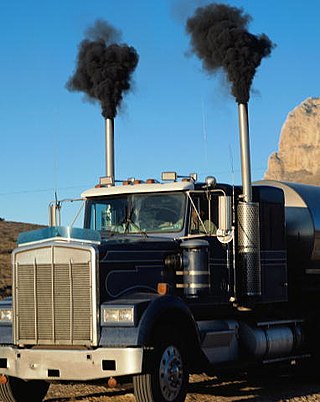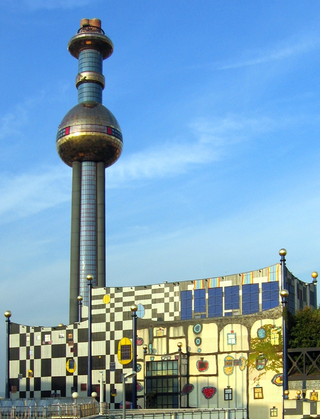Related Research Articles

Emissions trading is a market-oriented approach to controlling pollution by providing economic incentives for reducing the emissions of pollutants. The concept is also known as cap and trade (CAT) or emissions trading scheme (ETS). One prominent example is carbon emission trading for CO2 and other greenhouse gases which is a tool for climate change mitigation. Other schemes include sulfur dioxide and other pollutants.

Exhaust gas or flue gas is emitted as a result of the combustion of fuels such as natural gas, gasoline (petrol), diesel fuel, fuel oil, biodiesel blends, or coal. According to the type of engine, it is discharged into the atmosphere through an exhaust pipe, flue gas stack, or propelling nozzle. It often disperses downwind in a pattern called an exhaust plume.

The U.S. National Ambient Air Quality Standards are limits on atmospheric concentration of six pollutants that cause smog, acid rain, and other health hazards. Established by the United States Environmental Protection Agency (EPA) under authority of the Clean Air Act, NAAQS is applied for outdoor air throughout the country.
A State Implementation Plan (SIP) is a United States state plan for complying with the federal Clean Air Act, administered by the Environmental Protection Agency (EPA). The SIP, developed by a state agency and approved by EPA, consists of narrative, rules, technical documentation, and agreements that an individual state will use to control and clean up polluted areas.
New Source Performance Standards (NSPS) are pollution control standards issued by the United States Environmental Protection Agency (EPA). The term is used in the Clean Air Act Extension of 1970 (CAA) to refer to air pollution emission standards, and in the Clean Water Act (CWA) referring to standards for water pollution discharges of industrial wastewater to surface waters.
The best available technology or best available techniques (BAT) is the technology approved by legislators or regulators for meeting output standards for a particular process, such as pollution abatement. Similar terms are best practicable means or best practicable environmental option. BAT is a moving target on practices, since developing societal values and advancing techniques may change what is currently regarded as "reasonably achievable", "best practicable" and "best available".

The Capitol Power Plant is a fossil-fuel burning power plant which provides steam and chilled water for the United States Capitol, the Supreme Court, the Library of Congress and 19 other buildings in the Capitol Complex. Located at 25 E St SE in southeast Washington, D.C., the CPP was the only coal-burning power plant in the District of Columbia, and it now mostly uses natural gas. The plant has been serving the Capitol since 1910, and is under the administration of the Architect of the Capitol.

Waste-to-energy (WtE) or energy-from-waste (EfW) is the process of generating energy in the form of electricity and/or heat from the primary treatment of waste, or the processing of waste into a fuel source. WtE is a form of energy recovery. Most WtE processes generate electricity and/or heat directly through combustion, or produce a combustible fuel commodity, such as methane, methanol, ethanol or synthetic fuels, often derived from the product syngas.
Area sources are sources of pollution which emit a substance or radiation from a specified area.

Coal generated about 19.5% of the electricity at utility-scale facilities in the United States in 2022, down from 38.6% in 2014 and 51% in 2001. In 2021, coal supplied 9.5 quadrillion British thermal units (2,800 TWh) of primary energy to electric power plants, which made up 90% of coal's contribution to U.S. energy supply. Utilities buy more than 90% of the coal consumed in the United States. There were over 200 coal powered units across the United States in 2024. Coal plants have been closing since the 2010s due to cheaper and cleaner natural gas and renewables. Due to measures such as scrubbers air pollution from the plants kills far fewer people nowadays, but deaths in 2020 from PM 2.5 have been estimated at 1600. Environmentalists say that political action is needed to close them faster, to also reduce greenhouse gas emissions by the United States and better limit climate change.

The Clean Air Act (CAA) is the United States' primary federal air quality law, intended to reduce and control air pollution nationwide. Initially enacted in 1963 and amended many times since, it is one of the United States' first and most influential modern environmental laws.
To protect the environment from the adverse effects of pollution, many nations worldwide have enacted legislation to regulate various types of pollution as well as to mitigate the adverse effects of pollution. At the local level, regulation usually is supervised by environmental agencies or the broader public health system. Different jurisdictions often have different levels regulation and policy choices about pollution. Historically, polluters will lobby governments in less economically developed areas or countries to maintain lax regulation in order to protect industrialisation at the cost of human and environmental health.
Startups, shutdowns, and malfunctions (SSM) are periods of non-continuous operation in refineries, chemical plants or similar industrial facilities. During such temporary periods, these plants might emit larger amounts of pollution, and therefore the pollution abatement equipment may be unable to effectively control it.

The environmental impact of paper are significant, which has led to changes in industry and behaviour at both business and personal levels. With the use of modern technology such as the printing press and the highly mechanized harvesting of wood, disposable paper became a relatively cheap commodity, which led to a high level of consumption and waste. The rise in global environmental issues such as air and water pollution, climate change, overflowing landfills and clearcutting have all lead to increased government regulations. There is now a trend towards sustainability in the pulp and paper industry as it moves to reduce clear cutting, water use, greenhouse gas emissions, fossil fuel consumption and clean up its influence on local water supplies and air pollution.

Air quality laws govern the emission of air pollutants into the atmosphere. A specialized subset of air quality laws regulate the quality of air inside buildings. Air quality laws are often designed specifically to protect human health by limiting or eliminating airborne pollutant concentrations. Other initiatives are designed to address broader ecological problems, such as limitations on chemicals that affect the ozone layer, and emissions trading programs to address acid rain or climate change. Regulatory efforts include identifying and categorising air pollutants, setting limits on acceptable emissions levels, and dictating necessary or appropriate mitigation technologies.
The United States Environmental Protection Agency (EPA) began regulating greenhouse gases (GHGs) under the Clean Air Act from mobile and stationary sources of air pollution for the first time on January 2, 2011. Standards for mobile sources have been established pursuant to Section 202 of the CAA, and GHGs from stationary sources are currently controlled under the authority of Part C of Title I of the Act. The basis for regulations was upheld in the United States Court of Appeals for the District of Columbia in June 2012.
Entergy Corp. v. Riverkeeper, Inc., 556 U.S. 208 (2009), is a decision by the United States Supreme Court that reviewed the Environmental Protection Agency's (EPA) interpretation of the Clean Water Act regulations with regard to cooling water intakes for power plants. Existing facilities are mandated to use the "Best Technology Available" to "minimize the adverse environmental impact." The issue was whether the agency may use a cost–benefit analysis (CBA) in choosing the Best Available Technology or (BAT) to meet the National Performance Standards (NPS).

Point source water pollution comes from discrete conveyances and alters the chemical, biological, and physical characteristics of water. In the United States, it is largely regulated by the Clean Water Act (CWA). Among other things, the Act requires dischargers to obtain a National Pollutant Discharge Elimination System (NPDES) permit to legally discharge pollutants into a water body. However, point source pollution remains an issue in some water bodies, due to some limitations of the Act. Consequently, other regulatory approaches have emerged, such as water quality trading and voluntary community-level efforts.
Utility Air Regulatory Group v. Environmental Protection Agency, 573 U.S. 302 (2014), was a US Supreme Court case regarding the Environmental Protection Agency's regulation of air pollution under the Clean Air Act.

Exide was one of the world's largest producers, distributors and recyclers of lead-acid batteries. Lead-acid batteries are used in automobiles, golf carts, fork-lifts, electric cars and motorcycles. They are recycled by grinding them open, neutralizing the sulfuric acid, and separating the polymers from the lead and copper. In the US, 97 percent of the lead from car batteries is recycled - which is the highest recycling rate for any commodity. Most states require stores to take back old batteries.
References
- ↑ Top 100 civil Awards in the United States for 2005
- ↑ Air pollution emissions in Philadelphia, Pennsylvania
- ↑ Environmental Analysis for the O'Brien Cogeneration Project, Salinas California, Earth Metrics file reference 10167, Report for the city of Salinas, California, October 1989
- ↑ Noise Mitigation Plan, O'Brien Cogeneration Plan, Salinas, Ca., prepared by Collaboration in Science and Technology Inc., June 1989
- ↑ U.S. Environmental Protection Agency Economic Incentives Program, 1992